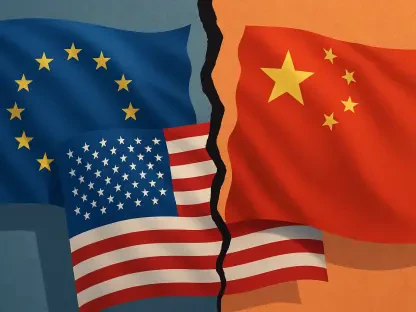Understanding China’s AI Content Labeling Law
China’s digital landscape has witnessed a seismic shift with the implementation of a groundbreaking regulatory framework titled “Measures for the Labeling of Artificial Intelligence-Generated and Synthetic Content,” effective as of this year. This policy, spearheaded by the Cyberspace Administration of China (CAC), mandates clear and identifiable labeling for all forms of AI-generated content. From text and images to audio, videos, and even virtual scenes, no digital creation escapes the scope of this comprehensive rule. The initiative aims to curb the rampant spread of misinformation and ensure authenticity in an era increasingly dominated by synthetic media.
The CAC’s role in this regulation builds on earlier efforts, such as the Deep Synthesis rules introduced a couple of years ago. This latest mandate represents a significant escalation in scope and enforcement, reflecting a strategic push to address digital deception head-on. By establishing rigorous guidelines, the policy not only targets fraud and fake news but also seeks to protect intellectual property rights in a rapidly evolving tech environment. The emphasis on transparency is evident in the detailed requirements for both creators and platforms to comply with labeling standards.
This law positions China as a trailblazer in AI governance at a time when global concerns over digital authenticity are at an all-time high. As misinformation and deepfake technologies proliferate, this regulatory framework sets a benchmark that could resonate far beyond national borders. The proactive stance taken by China underscores a commitment to shaping the future of digital trust, potentially influencing how other nations approach similar challenges in the governance of AI-generated content.
Current Trends and Market Dynamics in AI Governance
Key Trends Shaping AI Regulation
Across the globe, a marked shift toward stricter AI governance is unfolding as societies grapple with the perils of misinformation, fraud, and deepfake-driven scams. Governments and regulatory bodies are increasingly prioritizing policies that address the ethical and societal implications of synthetic media. This trend reflects a broader recognition that unchecked AI advancements could undermine trust in digital ecosystems, particularly in critical areas like elections and public discourse.
Emerging technologies, such as AI avatars and synthetic media, are amplifying the urgency for transparency and accountability. These innovations, while offering immense creative potential, also pose significant risks when misused for deceptive purposes. As a result, there is a growing demand for robust mechanisms to distinguish between real and artificial content, pushing regulators to act swiftly in establishing clear guidelines for identification and disclosure.
Consumer expectations are also evolving, with a heightened call for digital authenticity across platforms like social media, e-commerce, and news outlets. Users are becoming more discerning, seeking assurance that the content they encounter is trustworthy. This shift presents opportunities for innovation in labeling technologies and detection systems, as companies race to develop solutions that meet both regulatory demands and user needs, fostering a more secure online environment.
Industry Adoption and Compliance Metrics
Major Chinese platforms, including Weibo, Douyin, WeChat, and Xiaohongshu, have swiftly adapted to the new labeling requirements by integrating automated tools and real-time detection algorithms. These systems are designed to identify and tag AI-generated content seamlessly, ensuring compliance with the stringent mandates. The rapid response from these industry giants highlights a proactive approach to aligning with regulatory expectations.
Industry leaders like Tencent and ByteDance are taking compliance a step further by investing heavily in proprietary technologies, such as invisible watermarks that remain detectable even after content editing or compression. These innovations not only meet the current legal standards but also position these companies as frontrunners in setting industry benchmarks. Their efforts demonstrate a commitment to maintaining user trust while navigating the complexities of digital content management.
Looking ahead, the scalability of these solutions holds promise for broader adoption in global markets. As compliance technologies mature over the next few years, from this year to 2027, there is potential for these tools to become standard across international platforms. The success of Chinese firms in implementing such systems could inspire similar initiatives worldwide, creating a ripple effect that transforms how AI content is managed on a global scale.
Challenges in Implementing AI Content Labeling
The implementation of comprehensive labeling requirements presents significant operational and technological hurdles, particularly for smaller developers and platforms. Unlike industry giants with substantial resources, these entities often lack the infrastructure to integrate advanced labeling systems or detection algorithms. The financial burden of compliance could strain their operations, potentially limiting their ability to compete in an increasingly regulated market.
There is also a looming risk that stringent enforcement measures might stifle innovation within the digital content space. The cost of meeting regulatory demands, coupled with the fear of penalties, could deter smaller players from experimenting with new AI technologies. This dynamic raises concerns about creating an uneven playing field where only well-funded corporations can thrive, potentially curbing the diversity of creative output in the industry.
Additionally, the broader implications of state control over digital content cannot be ignored, especially given China’s history of stringent internet oversight. Critics argue that such regulations could impact freedom of expression, as the line between ensuring transparency and exerting control becomes blurred. Balancing the need for accountability with the preservation of a vibrant, open digital environment remains a critical challenge, requiring careful consideration of enforcement approaches and their societal impact.
Regulatory Landscape and Compliance Implications
China’s labeling mandate is notably detailed, employing a dual-labeling strategy that includes visible watermarks or text prompts alongside hidden metadata detectable by algorithms. This approach ensures that both users and automated systems can identify AI-generated content, fostering transparency across diverse digital platforms. The granularity of these requirements sets a high standard for compliance, emphasizing the government’s commitment to combating digital deception.
When compared to international frameworks like the European Union’s AI Act, China’s policy stands out for its comprehensive scope. While the EU focuses primarily on high-risk applications such as deepfakes, China’s regulations apply to all synthetic content, regardless of perceived risk. This broader application underscores a more proactive stance, though it also highlights disparities in global regulatory priorities, prompting discussions on harmonizing standards across borders.
For multinational corporations like Meta and Google, compliance with China’s rules is non-negotiable for maintaining market access. Adhering to these mandates could influence their global AI strategies, potentially leading to standardized labeling practices worldwide. Penalties for non-compliance, including fines and content removal, further incentivize adherence, shaping industry practices and user behavior. The ripple effects of these regulations may redefine how global tech firms approach content authenticity and regulatory alignment in various jurisdictions.
Future Outlook for AI Content Regulation Globally
China’s pioneering approach to AI content labeling is poised to set a precedent for global governance standards, potentially inspiring other nations to adopt similar policies. As digital ecosystems become increasingly interconnected, the framework established in China could serve as a model for addressing universal challenges like misinformation and fraud. This influence may accelerate the development of cohesive international guidelines over the coming years.
Advancements in generative AI and synthetic media are likely to act as disruptors, continuously shaping the regulatory landscape. As these technologies evolve, they will introduce new complexities that demand adaptive policies to keep pace with innovation. Regulators worldwide will need to remain agile, anticipating future risks while ensuring that frameworks do not lag behind technological progress, which could undermine their effectiveness.
The balance between transparency and innovation will remain a central focus, influenced by factors such as consumer trust and geopolitical tensions. Growth areas like AI ethics, user protection technologies, and cross-border collaboration on digital authenticity standards are expected to gain prominence. These domains offer opportunities for stakeholders to work together, fostering solutions that prioritize safety without compromising the creative potential of AI technologies in a global context.
Conclusion and Strategic Insights
Reflecting on the discussions, China’s AI content labeling law emerged as a landmark policy that redefined digital governance within its borders. It established a rigorous standard for transparency, compelling platforms and creators to prioritize authenticity in an era of synthetic media proliferation. The swift adaptation by major industry players underscored the feasibility of such regulations, even as challenges for smaller entities highlighted disparities in implementation capacity.
The global impact of this framework became evident as it sparked conversations about harmonizing AI governance standards across nations. Comparisons with other regulatory models, like the EU’s AI Act, revealed both the strengths and unique challenges of China’s comprehensive approach. The policy’s influence on multinational corporations also suggested a potential shift toward unified global practices, despite concerns over state control and innovation constraints.
Moving forward, stakeholders must focus on collaborative strategies to navigate this evolving landscape. Governments, platforms, and creators should engage in dialogue to refine compliance mechanisms that support smaller players while maintaining robust safeguards. Investing in accessible labeling technologies and fostering international partnerships will be crucial steps to ensure a safe yet dynamic digital environment, where user trust and content authenticity remain paramount priorities for the future.









